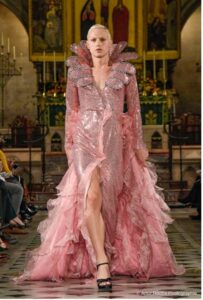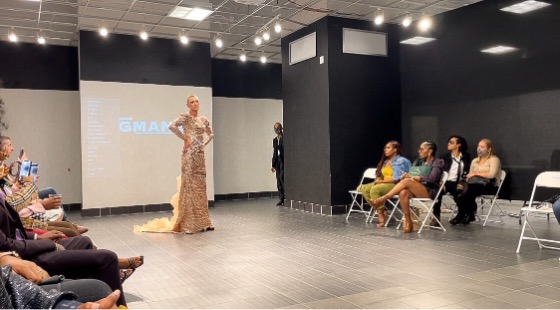Gender diversity and inclusivity? For the fashion industry? Groundbreaking.
The city of Chicago is taking strides to become known as a fashion capital that focuses on and celebrates diversity and inclusivity.
When people think of the fashion industry and its models, there will typically be a common theme or image that comes to mind. Usually, this image doesn’t apply or resonate with the average person either. This is something a few people right here in Chicago are trying to change.
“Something Chicago Fashion Week is trying to ignite is that identity, regardless of who you are, is strong and powerful,” said Tony Long, CEO and co-founder of FashionBar LLC. and creator of Chicago Fashion Week.
Before the evening wear show began, Long gave a speech about how fashion is a safe space.
“I think fashion is a safe space, and that’s very true. We implement this by supporting inclusive models; cisgender males and females, and transgender, nonbinary and gender non-conforming. Fashion doesn’t discriminate, so why should we?” he said.
Long said his company, FashionBar LLC., is the only company in the Midwest that supports all-inclusive fashion. In years past, fashion has seemed to showcase a standard type of model, typically tall, thin and cisgender. Long said all their models are very inclusive and so are their shows.
Of the shows FashionBar LLC. puts on, some center and focus on the transgender community, Muslim community, the upcoming class of fashion students and the urban and streetwear community.
“These are all related with one common ground, that identity is relevant in fashion,” he said.
Fashion forward
One of the brands at Fashion Week’s Evening Wear show was MEGMANSKI by designer Meg Lemanski. Lemanski’s daughter, Raquel, said her mother wants to design for anybody and everybody.
“Whether a trans person, androgynous, nonbinary or someone just wanting to dress up, Meg wants to cater to that need,” said Lemanski.
Scottie Larson works in HIV prevention as a counselor and also models. They closed Lemanski’s Chicago Fashion Week’s evening wear show on Oct. 17, 2021 by wearing a sparkling floor length gown.
Larson, who identifies as a nonbinary, queer human, first started walking in fashion shows last April. Larson said aesthetics and fashion have always intrigued them; touching on how fashion, aesthetics and beauty all set a tone and precedent for how life can be.
Larson went with Lemanski to walk in her shows at Paris and Milan Fashion Week. They said it was “absolutely mind-blowing, Raquel and Meg gave me a call in June and said, ‘We’re going to Paris and Milan, c’mon’. It felt truly glorious.”

Scottie Larson wearing MEGMANSKI at Paris Fashion Week 2021. Photo courtesy of Artur Rocha Photographie.
Lemanski said all models were able to walk for other designers, and that a lot of them utilized Larson. Lemanski was “so proud of that,” noting designers had them wearing not the typical masculine clothing worn by male models, but “very feminine stuff.”
“I was the only queer nonbinary essence in either of the shows, that just felt, it felt like a victory for queerness and nonbinary essences. I’m alongside these very cis-straight models, in a fashion industry that’s very cis-straight,” said Larson. “That was really fun to just throw on some gowns and blow people’s minds.”
Public perception
Larson appeared well-received during the show and different designers invited them to walk. Out in public, though, Lemanski said it was more of a mixed reception.
Walking down the streets of Milan with Larson there were “lots of looks, and they were dirty. Maybe not even dirty, more they didn’t know where to place them,” said Lemanski. However, it was the “complete opposite” in Paris. Lemanski explained how everyone wanted to take their picture with Larson.
When it comes to their brand, Lemanski wanted one thing to be clear. “The main thing is we’re all about inclusion; we’re LBGTQ+ friendly, whether someone is bigger, smaller, whatever, it doesn’t matter, it’s all about inclusion.”
More designs by MEGMANSKI you can be found on their Instagram.
Social media standstill
Larson also picked up on some hesitations with designers at Paris and Milan in a different sense.
“Something I noticed is in the aftermath of the shows, photographers were posting all the other models but not posting my photos. Designers are posting other looks, but not mine,” they said.
Due to being fairly new to the modeling world, Larson began to wonder if the photos weren’t the best.
“I got my hands on the photos and they look fine in the sense of having one eye closed, or looking like an idiot, so that’s been a curiosity of mine of what’s going on here. Photographers aren’t willing to post my photos, or designers aren’t willing to post the looks they put me in, and I’m not exactly sure why that is,” said Larson.

Scottie Larson wearing MEGMANSKI at Milan Fashion Week 2021. Photo courtesy of Emanual Smith.
More work to be done
Although on the surface it can seem like the fashion industry has made a lot of progress in diversity, social attitudes don’t change that quickly.
“I think we are at an interesting crossroads, where queerness is breaking into the mainstream more. I say that and then, you know, more trans women have been killed in this last year than any other year,” said Larson.
Larson said that while they do believe there is more visibility for queer folks, fashion has to make a choice. It takes a lot more to flourish as a designer these days, especially in the eyes of companies.
“If people don’t get out of the way and join us, then they’re going to get steamrolled. Let those dominoes fall as they may,” Larson said with a cheeky smile.
When it comes to Chicago, Long believes that “the power we have is in the inclusion, in the culture, in the diversity.” He also said Chicago is a diverse city, yet it was intentionally built on segregation 40-50 years ago. Long wants to ditch that and celebrate the diversity of its residents with FashionBar LLC and Chicago Fashion Week.
“If a company is not providing to all aspects of society then they have a lot to learn. They have to manage and communicate their plan with countries, cultures, moral ethics and values that align with that city and community, otherwise they aren’t getting that connection with that market community,” he said.
Nobody puts students in a corner
Another reason Long wants to establish Chicago as a fashion mecca is for the fashion students in the area.
“Chicago has 11 fashion schools throughout the city and suburbs, and schools are required by the state to place these students into an industry they’re studying,” Long said. “If there’s no industry then they don’t have a job, then they move to wherever there is that industry. If students want to stay in Chicago, they have $80k in debt and have to take a menial job.”
Long said the city is “doing an injustice to all these students who are supporting and believing in their city tirelessly, who are then forced to leave.”
The future of fashion
Long is not tackling this challenge alone. “You have to realize larger brands are coming out to really shatter the division between gender, masculinity, femininity and being body conscious. For example, Rihanna’s brand,” he said.
However, Long said some larger companies are failing, for example, Victoria’s Secret. They canceled their annual fashion show in 2019 following controversies surrounding a lack of diversity amongst their models, along with transphobic comments made by their former chief marketing officer.
As to what Larson thinks of this whole experience?
“The humanity of it all, I think what’s been really fun about exploring fashion, exploring gender, it’s all been just desperately human, and it’s been really exciting, but also desperately divine, and so, coming into each of our divine essences as humans is what fashion, is what expression, is all about. Fashion is the extension of self,” they said.

